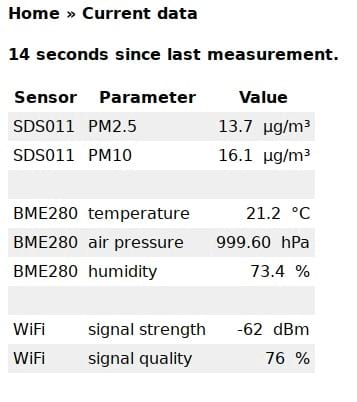1 unstable release
| 0.1.0 | Jun 25, 2022 |
|---|
#1566 in Hardware support
21KB
248 lines
Airrohr-mqtt
Airrohr-mqtt is a Homeassistant compatible mqtt bridge for the Airrohr. It sets up a webserver that takes requests from the Airrohr and converts them into MQTT messages.
Supported Features
Homeassistant features
- Device advertisement via MQTT
- Updating sensor values via MQTT
- Configurable sensor properties
Sensors
- SDS011 (
pm10,pm25) - BME280 (
temperature,humidity,pressure)
Building
Cargo brings most of the dependencies, however some libraries depend on native C libraries. On Debian based systems the following packages are required:
cmakelibssl-devpkg-config
Configuration
Webserver
The webserver is based on Rocket so it supports any
environment variables supported by Rocket. It will take the POST requests
generated by the Airrohr under the /api path.
Attention: The webserver does not support any authentication. Only make it accessible in trusted environments. Otherwise anyone is able to write any data into Homeassistant.
Settings
The server looks for a Settings.toml file in the local directory. This file
contains the following keys:
server: MQTT serveruser: MQTT usernamepassword: MQTT passwordsensors: Sensors configuration file
An example configuration can be found in Settings.toml.def.
Sensors
The sensors are configured in sensors.json. It is a map of Airrohr
sensors to Homeassistant sensors with additional information. E.g. the Airrohr sensor value
{"value_type": "BME280_temperature", "value": "23.50"}
will be transformed into a sensor configuration for Homeassistant to properly interpret the value received via MQTT:
{"BME280_temperature": {"class": "temperature", "unit": "°C", "value_template": "{{ value }}"}}
Additional sensors or different units can be configured without recompilation.
Airrohr
To configure your Airrohr enter the IP, domain and path into the custom API part of the API
configuration. The path should end on /api but can also have a prefix if you're using a
reverse proxy.

Running
To run the server just provide a Settings.toml file and run
$ cargo run
By default it will listen to localhost:8000.
MQTT Integration
The bridge publishes a device per Airrohr with all of its sensors with the following topics:
homeassistant/sensor/airrohr-12345678/<sensor name>/config
The configuration will include the topic for the value of each sensor. They look as follows:
airrohr/airrohr-12345678/<sensor name>


Dependencies
~31–61MB
~1M SLoC